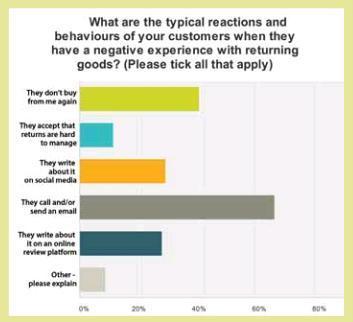RETAILERS KNOW THAT A POOR RETURNS EXPERIENCE CAN BE EVEN MORE DAMAGING THAN A POOR SALES EXPERIENCE SINCE IT WRECKS TRUST BUT COULD THEY BE DOING MORE TO LEARN FROM A RETURN?
Offer a poor sales experience and you could lose a sale and perhaps a customer. Offer a poor returns experience and not only will both the above happen but you will likely have also angered the customer enough that further bad mouthing of your business – whether privately to friends and family or more publicly on social media – is likely.
Yet learning from a returns experience – whether good or bad – is the very best way of improving the experience for customers old and new alike. In our survey therefore we looked at how retailers capture feedback from their customers on their experiences when returning goods.
Jan Vels Jensen, chief marketing use returns to their advantage. “Returns are going to happen, so as a retailer it is important to make sure you learn something from them,” he says.
Worryingly a massive 43% said that they didn’t capture feedback on such experiences meaning that they are likely to be missing out on rich learnings within their business.
Retailers need to improve their effectiveness in this area. More than a third (38%) said they monitored returns experiences through online surveys. However the take-up of such surveys is often low so the value of doing this is doubtfull. Close to one in five (19%) said they monitored feedback by specific follow up calls with the customer and 10% via feedback cards.
Liam Price, digital merchandiser at Warehouse , says the experience of customers is a big consideration for the retailer when reviewing the returns proposition it offers and that it works hard to communicate with its customers on this. “Customer retention is so important particularly in such a competitive retail environment. We speak to our customer weekly via return surveys to a find out why she returned and b)how was her experience of returning. This is something we then review on a monthly basis,” he says.
At this point any negative trend are highlighted and then the appropriate action taken. Price says this also works well with the customer since it shows the retailer cares enough to take action. “This is also a great way to re-engage the customer by apologizing, offering to listen and reminding her about all the newness hitting down onsite. A return should not been as a negative, it’s another sales channel that needs to be optimised,” he says.
Trustpilot’s Vels Jensen agrees: “The depth of consumer data we can track today provides unique insights for managing returns, but it still remains crucial to ask for feedback when someone returns something,” he says. “If you understand the reasons behind a return, you can try and stop it from reoccurring and it creates a human angle especially important for online retailers,” he says.
Andy Young, manager at outdoor retailer Fox’s Outdoor, says his business will work hard to ensure the customer is happy since customer service is so important in retaining customers that have already spent with you and who you don’t want to lose in the future. “You only lose a customer once but you spend a small fortune in attracting them in the first place, ” he says. “Being able to deal with a return to the customer’s satisfaction is an excellent way to keep a customer for life and actually turn a negative into a positive. We rarely say no to a customer,” he says.
He believes that speed is of the essence when it comes to the best resolution for a returns issue.
“We know when there is a problem when we first get the email complaint or when the parcel drops into our returns tray and we solve it by dealing with it immediately as people get anxious that they are not going to get their money back. Regular communication is the key,” he says.
And as another small business DiamondGeezer.com CEO Clive Billing shares the same ethos. “We do bend over backwards and make it as fast as possible. We refund their card immediately on receipt of goods but also advise them that it can take credit card companies take three days to refund. We handle returns with the same attention and care as we handle a sale because we want people to have the same sales experience. It’s very important that our customers love us,” he says.
Since this need to keep the customer happy is so crucial – since realizing that firstly there has been negative feedback and secondly acting on it can be the difference between losing or keeping a customer in the future – we asked in our survey how retailers addressed negative feedback regarding returned items.
The responses varied. “Our response is through the same medium (email, social media etc) as feedback is given. There is always an apology and it is handled sensitively, but the rest of the response is personalised and varies according to the situation,” said one retailer in the survey.
Whilst some will deal with such feedback in the same public arena in which it was first aired others will take the complaints offline as soon as possible with the issue acknowledged online but the complaint then dealt with offline via the customer service team. “We contact the negative customer and post a response on the medium used to place negative post,” says one retailer.
Usually this is on social media channels such as Facebook and Twitter and means therefore that a retailer has to keep on top of monitoring such channels. At catalogue retailer Boden customer services manager Peter Hutton says the retailer monitors social media very closely. “Every Facebook comment is read and we go back to the customer if we need to,” he says. He also highly rates its effectiveness as a learning and customer service channel and for getting honest feedback from a customer.
“That’s one of the better ways of getting direct feedback. Facebook is becoming a really good way of picking up things when customers are upset,” he says.
Yet despite this and the growing trend to use social media for both praise and complaints our survey showed that that only 17% of retailers said they kept an eye on social media for feedback on experiences when returning goods.
Retailers generally know that customers are rarely understanding – only 11% said that their customers appreciated that returns are hard to manage – and nearly a third (29%) said that their customer’s typical reaction to a negative returns experience would be to write about it on social media. This point makes the previous figures eve more shocking.
Our survey also showed that upset customers wouldn’t simply restrict their bad feeling to one channel. As well as the proportion who would take to social media our survey also showed that 28% would write about the experience on an online review platform and nearly two thirds (65%) would call or send an email to complain.
Worryingly 40% of retailers admitted that they realized that a typical reaction of their customers to a poor returns experience would be to not buy from them again – a figure they really can’t afford not be addressing and showing the importance of learning from returns.
The importance of reviews
Of course feedback on returns isn’t restricted simply to such channels. Another growing channel of feedback is customer reviews – either on the company’s own sites or third party sites. And retailers realise their importance. When asked in our survey what they thought about online reviews more
than half said they saw them as very important as a source of feedback; were very important for measuring customer satisfaction and said that monitoring reviews written about their company was
very important to them. Their feelings are perhaps best summed up by this respondent to the survey whose approach epitomizes good practice in this area. “We are open if a mistake is ours, or we present a reasoned argument if it is not. We make sure our feedback is visible mainly for the benefit of future customers who do look at reviews and often focus on the negative ones. We believe it is important to show a reasoned argument with this type of feedback,” said the retailer. Jan Vels Jensen, chief Trustpilot, says reviews platforms are vital. “Especially in self-service online environments where support may be perceived hard to access or non-existent
it is crucial to create a feedback loop between customer and retailer for handling online returns as it not only allows you to evaluate the quality osupply chain in real time, but gives you real-timeinsights into the concerns and challenges a customer may encounter when dealing with returns,” he says. “Online review platforms such as Trustpilot’s empower the retailer to manage this feedback through a controlled environment where they can not only invite the customer to share their experience but also engage with them in real time to manage their expectations and ensure customer satisfaction,” he says. He also points out that reviews help to prevent returns in the first place. “The user stories provided through online reviews allow shoppers to avoid potential issues with products, or to find the product that is best suited to its intended use by reading the experiences shared by their peers. These reviews help the shopper address questions, concerns and issues that arise during the buying process without the need of a sales assistant and provides the reassurance or social proof they seek after before deciding on a purchase,” he says. Showing you have listened to any complaint is vital but with a returns experience even more so. Being seen to acknowledge a complaint – whether the complexities of that complaint are managed on or off line is crucial and yet we saw some retailers saying they take no action against negative feedback leaving it looking as though they simply can’t be bothered and leaving the customer unhappy and potentially badmouthing the business. Being seen to address the problem is key and where the retailer has truly been shown to go beyond the call of duty is vital. “We leave personalised responses on review websites leaving a name and position within the company,” says one retailer in the survey. Vels Jensen says this is extremely important for repeat custom. “No company wants to lose value lifetime customers lover one mistake – online reviews are a useful communication opportunity. Excellent customer service is a powerful retention mechanism and a brilliant selling point,” he says.






